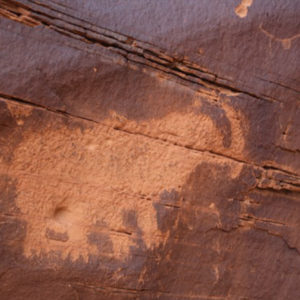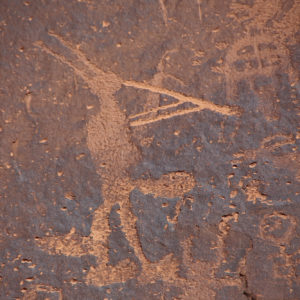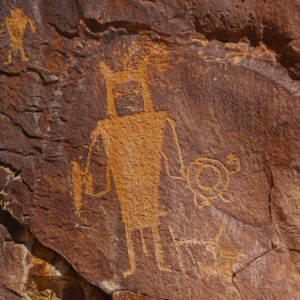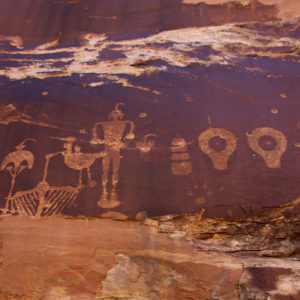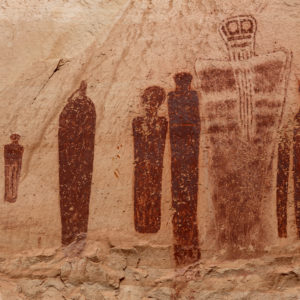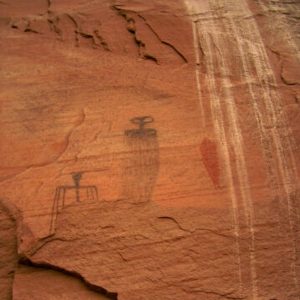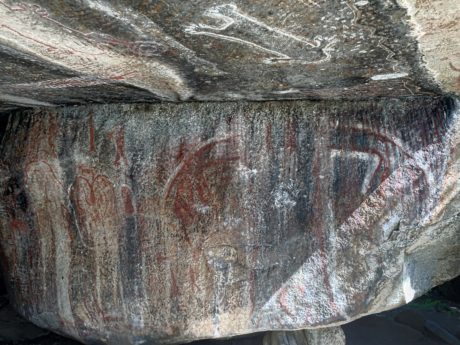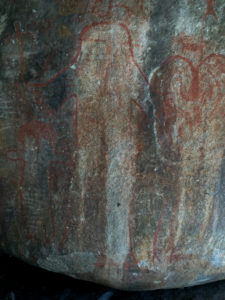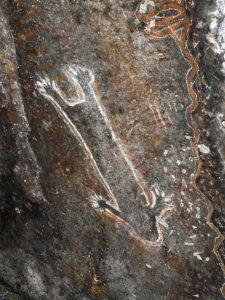Rock Art: Beyond Ancient Aliens
— Aliens, Unicorns, and Bigfoot
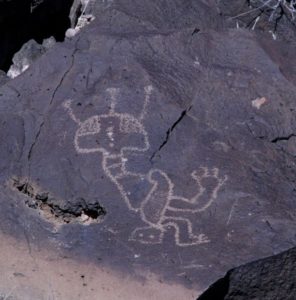
At the recent Alien Con I attended some of the sessions featuring Giorgio Tsoukalos, Erich von Däniken, and David Childress. I had never seen an episode of Ancient Aliens, but had kept informed through Jason Colavito’s excellent blog and his reviews of the show. He watches it so you don’t have to wade through the many episodes.
Other than that, the closest I have come was when I was exploring the geology at Giant Rock in the California desert and arrived as one of the talking heads on the show was taping an episode. The entire crew were unfriendly, secretive, and were not saying anything I have not heard elsewhere. I was not sure why they were entitled to order me on the public lands there, but they were there first and I was more accommodating to them.
I also was once given a book by David Childress but his promotion of obvious hoaxes — such as the newspaper myth of lost civilization in a cave at the Grand Canyon — soon grew tiresome. So I came well prepared.
At Alien Con, Tsoukalos seemed particularly upset about those who had raised concern about the racist implications of the Ancient Astronaut theory — the idea that native cultures could not have created so many things in the archaeological record. There is reason to be concerned about that. Erich von Däniken, for instance denied he was a “racialist” but in Signs of the Gods he asked “whether the black race was a failure and did the extraterrestrials change the genetic code by gene surgery and then programme a white or a yellow race?” He assumed “nearly all negroes are musical: they have rhythm in their blood.” (See
Tsoukalos maintained that no one on the Alien Con panel would say that aliens built the many megalithic monuments or other ancient structures, but everyone needs a teacher. He maintained that aliens taught people how to do it. Yet, the past is not a single progression and there are many
The idea that humans had to learn from aliens makes me wonder why they stopped teaching. We have things to learn today. Tsoukalos stated that humanity was twice rescued when we were on the verge of extinction but that he would not count on that happening again — the most important thing was the earth itself. On this point we might use different terminology but I agree that humans should not expect to be rescued should our species collapse. Perhaps though any aliens checking in on us could explain the reality of climate change to many of their believers.
“Childress thinks that geometric shapes in the rock art look like aliens”. – Jason Colavito, reviewing Ancient Aliens.
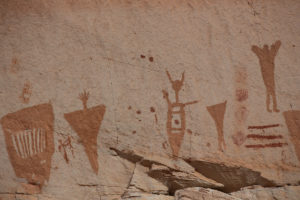
The statements about rock art particularly drew my interest.
Tsoukalos said that he was simply looking at what the ancients portrayed and taking them seriously. My problem with that is that no one knows what the rock artists meant. You can ascribe any number of meanings to them, but just because modern settlers think they look like aliens or astronauts does not mean they looked that way to the artists, or were meant to portray that. The mind’s ability to see interpret shapes or symbols in rock art is part of apophenia or pareidolia — similar to how we find meaning in the designs of clouds or rock formations. Such ideas have been worthy of the prestigious CRAP award (Certifiable Rock Art Prevarication).
The meaning of some rock art was linked to things we do not know or have not experienced. There are certain images we can understand — a sheep, elk, a herd of animals, or a hunt. Beyond that we enter the realm of speculation where it is easy to ascribe meaning based on the lens we use to view the art.
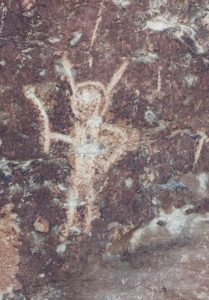
It is apparent some of the depictions said to be pilots or astronauts would show very primitive technology, more akin to what we had in the early days of the space program rather than that belonging to a space-faring civilization visiting the earth. Why would an ancient visitor be flying in a capsule?
We often see what we want to see. As an example, some people might look at this petroglyph from Fremont Indian State Park in Utah and believe it to be an ancient astronaut. It is a more modern Paiute work, about 150 years old.
It doesn’t take too long to discover mysterious imaged. A panel in the Coso range in California depicts an undoubtedly powerful figure. That does not mean it shows an alien. It was said to me as depicting an a shaman and his dog, with other figures around it. Perhaps even that is saying too much. I prefer to let the rock art speak for itself and spend less time trying to decipher what it might have meant for a particular time and culture.
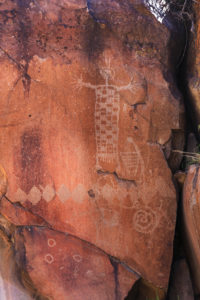
If the ancient cultures were simply recording what the saw in a way that we can understand, how do we interpret a mastodon in the Utah desert, the images of Kokopelli, or the host-like figures of the Great Gallery in the Canyonlands?
The rock art we see in the Southwest, the Mayan ruins, and ancient things throughout the world, have a profound meaning to many, but by simply labeling various depictions as ancient aliens or astronauts, often isolated from any kind of context, the alien advocates show appropriates the culture and the people who made them. It misses the point.
Unicorns
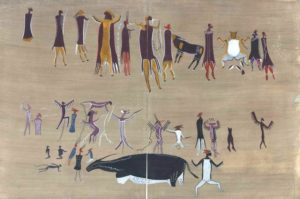
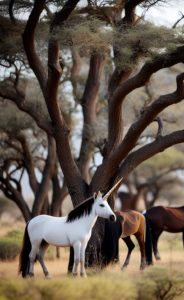
When John Barrow arrived at the Cape in May 1797, he made a facsimile of a rock paining that he identified as a unicorns. Perhaps not surprisingly, his unicorns resembled what was known to the Europeans. The South African variety was closer a one-horned antelope.
Wilteson looked at the one-horned creatures in the beliefs of indigenous Southern African peoples. He identified African unicorns as being part of beliefs relating to a rain god.
A report to the South African Archeological Society summarized a talk by Wilteson: “In the colonial period, there was much unrealised confusion about unicorns. Europeans searched for the unicorns of their myths without realizing the uncanny resemblance between their unicorns and what appeared to have been the one-horned antelope-like rain animals in San belief. The rock paintings and San comments help us to appreciate the similarities and the differences. The creatures in the rock paintings are rain animals not unicorns.”
Ancient Alien proponents could learn from this example. The colonialists looked at indigenous beliefs and rock art and filtered it through their lens. As a result., they lost track of what they were looking at. The alien enthusiasts today make the same mistake
Bigfoot
I think the world is a better place with Bigfoot included. There are numerous indigenous accounts of the Big Man. Perhaps the most interesting of the rock art showing a Hairy Man is on the Tule River nation. The importance of the pictographs to the People is well documented. Bigfoot is many things. He created the first person, he hunted other animals and people learned not to leave their acorn meal unattended lest Bigfoot steal it. He can be a protector, healer, or spirit guide. He is still seen in the area.
I was fortunate to be taken to the Hairy Man pictographs by an elder. The panels may be 1000 years old and have always been an important part of the culture. The elder spoke of the stories, their role, and recent sightings. The pictographs are integrated into the culture in a way that goes beyond most of the Ancient Aliens examples.
Although some point to the indigenous understanding of the Star People, it is different than saying that a particular piece of rock art shows aliens or that astronauts are shown at other sites. We cannot determine what the alien rock art meant to the people at the time. We know that the Hairy Man pictographs continues to serve the native peoples today.
What that means is left to the viewer. The elder just let me look and explained his tradition. The interpretation is up to you.
